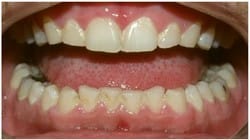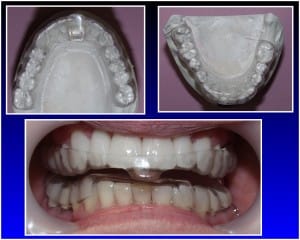 This photo shows teeth shortened by bruxism. This photo shows teeth shortened by bruxism. Of the three causes for tooth loss, the one that surprises most people is excessive bite forces. The American Dental Association says that approximately one in three adults grind their teeth when they sleep. The condition, called bruxism, places unhealthy forces on teeth that can cause flattened or worn-down teeth, chipped areas at the gumline, loose teeth, and damages to your jaw joint. The most frequent causes of bruxism are stress and bite discrepancies. In a healthy bite, the teeth come together in harmony to protect the teeth and your jaw joint. That harmony can be lost when you have periodontal disease, tooth crowding, or missing teeth that have allowed the remaining teeth to shift or tilt. Even if your bite is perfect, stress can cause you to grind your teeth. Of people that are restless sleepers, 95% grind their teeth. The same brain activity that causes you to toss and turn also causes the bruxing. Let’s look at an example of bruxism. In the first photo, the teeth have already been shortened by at least one-fourth of their length. Often patients with problems even this severe are not aware that they are bruxing, and many will even deny it when shown the severity of the problem. And if your spouse sleeps more soundly that you, he or she may also be unaware of the problem. As a dentist, I hear patients make comments like “I sleep with my mouth open, so that can’t be happening.” Bruxing doesn’t occur constantly when you sleep, but if it’s happening, it still will cause damage. Below are some questions that may tell you a problem is present:
One treatment for bruxism is the use of a bite guard. A bite guard is a plastic appliance that fits over your teeth and protects them from damaged that’s caused by grinding. The kind of bite guards sold at the pharmacy can actually make things worse. Custom nightguards can be made that are extremely comfortable, and the newest designs, like the one shown here, actually have a relaxing effect on the muscles. If the arrangement of your teeth lacks harmony, there may be advantages to changing how your bite comes together. Orthodontic treatment (“braces”) can make dramatic changes, or your dentist can use a process called equilibration to reshape the biting surfaces of your teeth to improve the way they come together. Those in and around Fleming County, suffering from tooth grinding and other issues from Bruxism, should contact Dr. William Moorhead, at Flemingsburg Dental care. If you’re suffering headaches, or see tooth wear that you’re concerned about, give us a call at 888-733-3163. Your teeth and your mouth will thank you!
0 Comments
 Periodontal Disease - Before and After Treatment Periodontal Disease - Before and After Treatment Periodontal disease is the number one cause of tooth loss in adults. Also known as “gum and bone disease”, it acts much like termites on the foundation of your house. And like termites, the disease is silent until it is very advanced. These are photos of one of our patients before and after periodontal treatment. In the left photo, notice the swollen, red gums and the thick tartar on the teeth. When she first came to our office, this patient had periodontal pockets that extended up to 6 mm (1/4”) under the edge of her gums. In addition to improving her appearance, her breath also dramatically improved. Bacteria thrive in the deep periodontal pockets. The bacteria and its by-products create plaque, and the plaque eventually absorbs calcium from the mouth to form calculus, or in lay terms, tartar. Calculus leaves a very rough surface on the root of the tooth, and even allows the bacteria to imbed itself onto the root surface. Treatment for periodontal disease is primarily aimed at removing the bacteria that cause the disease. One of the primary treatments for periodontal disease is root planing, where the hard deposits of calculus are removed from the root surface, then the root surface is smoothed to remove infected tooth structure. Unlike an ordinary cleaning appointment, root planing is performed in a very detailed fashion under the gums. Root planing can be done comfortably, either by numbing the treated area, or with a product called “Oraqix” that delivers topical anesthetic gel gently into the periodontal pockets to numb the gums without injections. To keep patients even more comfortable, we recommend they take a non-steroidal medication like Advil or Aleve before the root planing, which results in a dramatic decrease in inflammation and discomfort from the procedure. Our office is one of a few in the United States that has ozonated water available to aid in treatment during root planning. In it’s July 2008 edition, the Journal of Contemporary Dental Practice stated that “ozonated water strongly inhibited the formation of dental plaque…(showing that) ozonated water is useful in reducing infections caused by microorganisms present in dental plaque.” Improved home care is also a must in treating periodontal disease. Different tooth brushing techniques are taught to provide additional gentle massage for the infected gums, and daily use of floss or floss substitutes also greatly improve healing. When periodontal pockets are especially deep, a referral to a periodontist, a specialist in gum surgery, may be needed to improve the chances of saving teeth. Because your toothbrush and floss cannot reach further than 3mm (1/8”) below the gums, patients with periodontal disease usually require more frequent cleanings. Only a dental professional can reach these deep areas. By allowing your dental hygienist to perform this gentle cleaning every three months, harmful bacteria are disturbed before they can cause additional damage.  Doctors from Yale & Case Western Reserve released a study that discovered new bacteria that may be responsible for most premature labor. The Discovery Channel report says that this previously undiscovered bacteria usually found in the mouth may be responsible for up to 80 percent of early pre-term labors. Most importantly, the research indicates that preterm births can be prevented by improved oral hygiene and by the use of targeted antibiotics. We’ve known for several years now that pregnant women with gum disease problems were at a very high risk for premature labor. Obstetricians and insurance companies have been encouraging expectant mothers to see their dentist at least by their second trimester to have their teeth cleaned and treat any problems with swollen gums. There is also interesting news to share with new parents. We’ve all seen studies that show how breast feeding helps infants be more healthy. Regarding dental decay on teeth of a newborn, research shows that breast feeding not only does not cause cavities, but it actually deposits calcium and other useful nutrients onto the enamel. It has helps prevent decay! In our community, we still see too many children that have very high decay rates. We learned about seven to eight years ago that if either parent has a high decay rate when their child’s first teeth erupt, their child will have a much greater chance of always having decay problems. All of us understand that parents are going to be in close contact with their baby – including kisses and hugs. The close contact causes the bacteria in a parent’s mouth to get spread to their child. So if the parent has bacteria that have caused lots of cavities, that bacteria gets spread to the child. This information shows how important it is for parents to see their dentist – for their child’s sake. |
Articles
All
AuthorDr. Moorhead and his team write about dental news, and answer patient questions. Archives |


 RSS Feed
RSS Feed